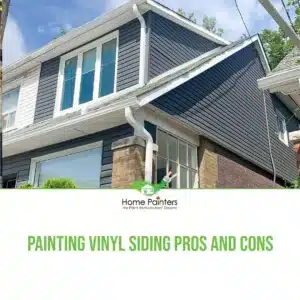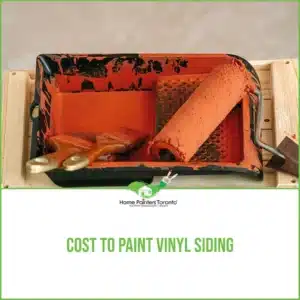
Deciding to work with your vinyl siding may come with lots of questions. How to repair vinyl siding? Can you paint vinyl siding? How to clean vinyl siding? Do you need special paint for the vinyl siding? What about the vinyl siding colours? Depending on the size of your home, all these questions may feel overwhelming. Whether you are thinking of painting vinyl windows versus replacing them, we have you covered. Preparation for a job like this is key – gathering as much information as possible and researching procedures, tools, and materials. When doing this research, be sure to think of us! At Home Painters Toronto, we can answer all your questions and provide a helping hand.
Choosing the Right Paint for Vinyl Siding
When painting vinyl siding, selecting the right paint is crucial.
Here are some factors to consider when choosing the best vinyl siding paint for your project:
Acrylic paint: Look for high-quality 100% acrylic paint for vinyl siding. Acrylic paint adheres well to vinyl surfaces and is resistant to fading, chalking, and peeling. Many paint manufacturers offer acrylic paint for vinyl siding, which can provide excellent results.
Low LRV (Light Reflectance Value) paint: When choosing a paint colour, it’s essential to consider the LRV, which measures the light a colour reflects. When exposed to excessive heat, vinyl siding can be susceptible to warping or buckling. To avoid this issue, choose a paint colour with a similar or lower LRV than your existing siding. This will help prevent heat buildup and potential damage to your siding.
UV-resistant paint: Vinyl siding is constantly exposed to the sun, which can cause the colour to fade over time. To ensure your paint job lasts as long as possible, choose a paint with UV-resistant properties. This will help protect your siding from the harmful effects of the sun and maintain its vibrant colour for longer.
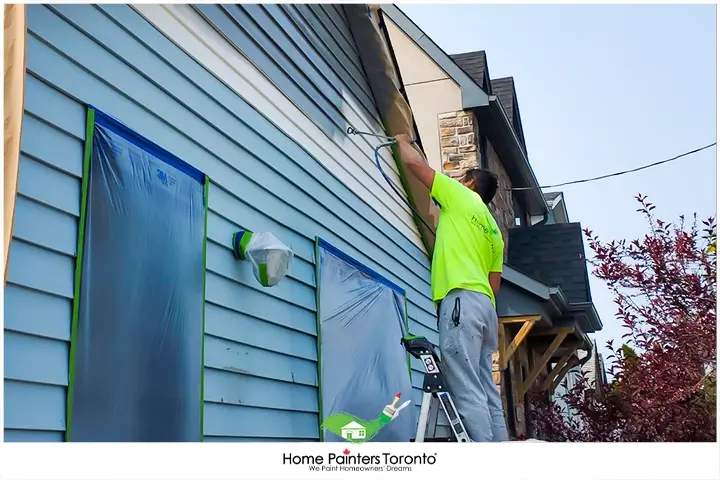
Tips for Painting Vinyl Siding
Now that you know what kind of paint to use on vinyl siding, here are some tips to ensure a successful painting project:
Below are some major factors to consider when painting vinyl siding.
1. Keep in Mind That Temperature Affects Vinyl
In frigid weather, vinyl will be more rigid, and the more heat it absorbs, it can become warped. This will start to occur when exposed to sunlight and temperatures above 160 degrees Fahrenheit or 70 degrees Celsius. And when exposed to freezing temperatures of around 30 degrees Fahrenheit or just about 0 degrees Celsius, vinyl panels may crack. From season to season, this expanding and contracting motion is something to remember when installing or choosing the best paint and colour.
2. Harsh Weather Conditions
Harsh weather conditions may affect the painting process with vinyl siding. While most people will choose to do an exterior home painting in early summer or early fall, the temperature, windiness, humidity, rain, or snow forecast is always something to monitor when preparing and scheduling this type of project.
3. Avoid Using Darker Paint Colours
When thinking of your favourite paint colours, staying away from something too dark is best. Some darker exterior paint colours that absorb the sunlight have reached temperatures as extreme as 220 degrees Fahrenheit or just above 100 degrees Celsius. If you have your heart set on a colour that is on the darker side, it’s best to make sure that you choose light-reflective. Something higher than 55 LRV.
4. Primer-Necessary Paint Situations
While most paint manufacturers have some paint options with built-in primers, there are situations where a primer is recommended for outdoor vinyl.
Primer – made with resin -helps the paint colour stick and look more solid with fewer coats. It also creates a smoother finish and is most often white or neutral in colour. If your vinyl siding has any dips and pores, it is better to use primer – though in many cases, if the vinyl is smooth, it is unnecessary. If you use primer, a latex-based one is best for exterior projects.
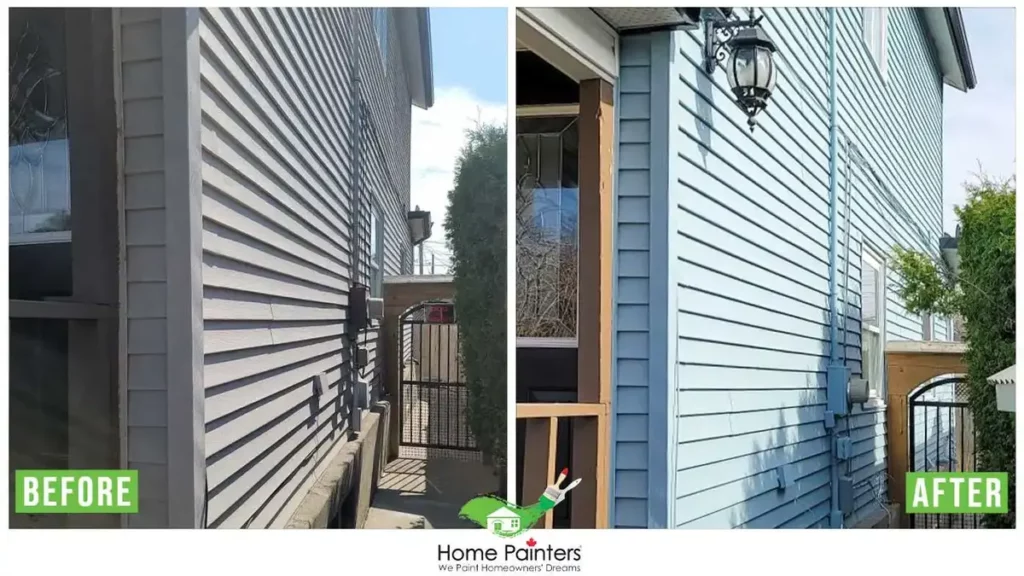
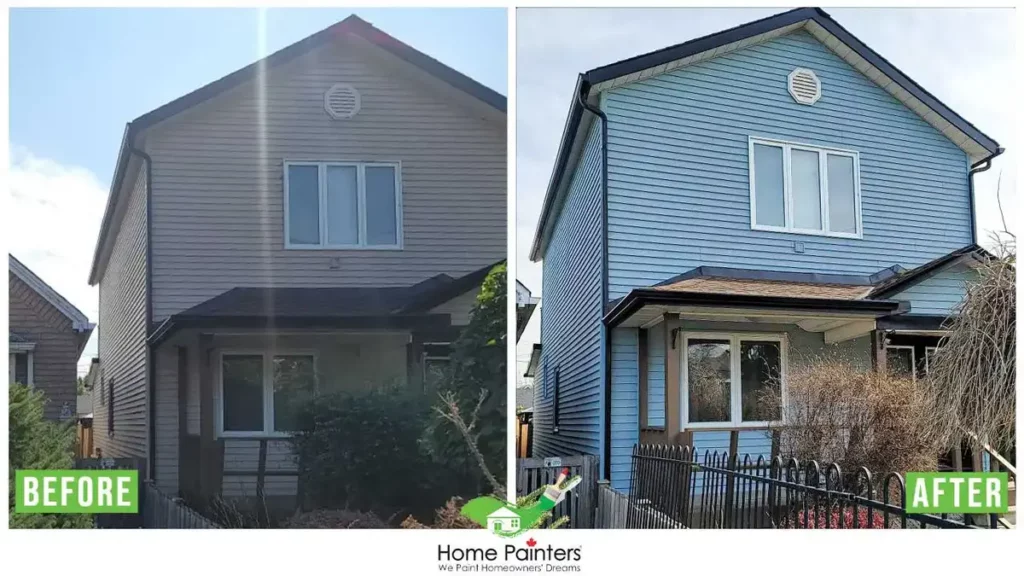
5. Benefits of Using Acrylic Paint
Acrylic paint will naturally expand and contract as the weather and temperature change. Chemically based, it doesn’t discolour easily and adheres to surfaces well. Acrylic paint will chip and crack less, which makes it durable for outdoor use.
6. Benefits of Using Latex Paint
While latex paint is not as commonly used on vinyl siding, it can be less expensive than acrylic and easy to apply. As it is water-based, it dries faster and has a milder scent. If you decide to use latex paint, choose one that is good for outdoor use. Latex paints are already great for weather resistance on a variety of surfaces.
7. How Many Coats?
Two coats of paint are usually enough on a well-cleansed and primed surface. Two coats are often plenty if your chosen colour is slightly darker than the previous one. You may need to apply more coats if your chosen colour is lighter or a particular bright colour beneath that distorts your colour. Though this may cost more, it will look better and last longer.
8. Rolling, Brushing and Spraying
While paint spraying may save time – on a day that isn’t windy – the paint may not provide as much coverage on large flatter surfaces. Using a spray-on exterior vinyl would be more common on windows than siding. Using a roller is easiest for large flatter surfaces, and for the edges and details, you guessed it, the brush is best!
Painting Vinyl Siding: Pros and Cons
Pros of Painting Vinyl Siding
Cost-effective: Painting your vinyl siding can be a cost-effective way to refresh your home’s exterior without the expense of replacing the siding entirely. High-quality paint can give your siding a new lease on life, extending its lifespan and improving your home’s curb appeal.
Wide range of colour options: One of the benefits of painting vinyl siding is the ability to choose from a wide range of colours. This allows you to customize the appearance of your home to suit your personal taste and style.
Improved UV resistance: Over time, vinyl siding can fade due to exposure to the sun’s UV rays. By applying high-quality, UV-resistant paint, you can help protect your siding from further fading and maintain its vibrant colour for a longer period.
Easy to clean: Painted vinyl siding is easy to clean and maintain. Regular cleaning with a gentle soap and water solution can help keep your siding looking fresh and new.
Environmentally friendly: Painting your vinyl siding, rather than replacing it, can be a more environmentally friendly option. By extending the life of your existing siding, you reduce the amount of waste that ends up in landfills.
Cons of Painting Vinyl Siding
Not a permanent solution: While painting vinyl siding can extend its life and improve its appearance, it’s not a permanent solution. Over time, the paint may chip, peel, or fade, requiring additional maintenance and repainting.
Potential for damage: When exposed to excessive heat, vinyl siding can be susceptible to warping or buckling. You may increase the risk of heat-related damage if you choose a paint colour with a higher light reflectance value (LRV) than your existing siding.
Limited warranty coverage: Some vinyl siding manufacturers may void the warranty on their products if they are painted. Before painting your siding, check with the manufacturer to ensure that doing so will not affect your warranty coverage.
Requires proper preparation: Painting vinyl siding requires thorough preparation to ensure proper paint adhesion and a smooth, even finish. This includes cleaning the siding, repairing damage, and possibly applying a primer. Skipping these steps or cutting corners can lead to a poor-quality paint job that may not last.
Weather-dependent: Painting vinyl siding requires specific weather conditions for the best results. Ideally, the temperature should be between 50°F and 90°F (10°C and 32°C), with low humidity and no rain in the forecast. Painting in unfavourable conditions can result in poor paint adhesion, an uneven finish, or other issues.
If you follow the steps, painting your house can take 2 – 10 days, depending on the surface area. And as long as you plan, it can go faster with the right weather conditions and a few extra hands. So there you have some essential things to consider while preparing to paint vinyl siding. Painting the exterior of your home may seem like a daunting project, but if you are organized and equipped, your vision is worth the effort. And if you’re unsure where to begin, don’t hesitate to reach out! At Home Painters Toronto, we can paint your dreams into reality.
How Much Does It Cost To Paint Exterior Vinyl & Aluminum Siding?
Top Related Blogs to
“What Kind of Paint Do You Use on Vinyl Siding?”
If you reside in Toronto and the GTA and need help figuring out the interior painting costs per square foot, don’t hesitate to call us! We will help you pick the colours you want and show you the latest painting and home renovation trends. Our home painting services with the best pro painters have been around for over 36 years.
Call 416.494.9095 or email [email protected] for a FREE quote for your home painting needs. And don’t forget to check us out on our social media channels below!



